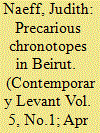|
|
|
Sort Order |
|
|
|
Items / Page
|
|
|
|
|
|
|
| Srl | Item |
| 1 |
ID:
172379


|
|
|
|
|
| Summary/Abstract |
This article argues that the intersection of time and space in large parts of the Levant is, above all, precarious. With a close analysis of two meaningful places in Beirut – the shrine of Rafic Hariri and the nightclub B018 – the article seeks to tease out how such a precarious chronotope is given form, meaning and value through narratives, practices and spatial design. Moreover, the article builds upon Walid Sadek’s conceptualisation of shared mourning as a possibility for a new sociality under Lebanon’s precarious conditions. It argues that despite their engagement with loss, the two sites under scrutiny here do not allow for such an ethical position. The findings of the analysis are relevant for the Levant more broadly as the flows of refugees in recent years have produced new and particularly precarious geographies inscribed with a profound sense of loss and grief.
|
|
|
|
|
|
|
|
|
|
|
|
|
|
|
|
| 2 |
ID:
106880


|
|
|
|
|
| Publication |
2011.
|
| Summary/Abstract |
Recent political events, such as the coup of 2006 or the 'Red Shirt' uprisings of 2010 underlined the divisions in Thai society between the provinces and the capital. As one of the world's most primate cities, Bangkok exerts a tremendous political, economic and cultural force upon the rest of Thailand. But how is such pressure interpreted, internalised and/or subverted? In this article, I look at Thailand's second-largest city, Chiang Mai, in Thailand's North, and the struggle to cure an increasing sense of urban crisis and thereby assert the former independent capital's symbolic authority vis-à-vis Bangkok. I examine this by looking at two specific discourses: that of architecture and spirit mediumship. Northern Thai architects attempt to cure Chiang Mai's ills through recourse to the 'cultural heritage' of the city's urban space, while spirit mediums call upon the sacred power of that space in order to restore Chiang Mai's 'lost' prosperity. The focal point for each effort lies at the city's centre: the Three Kings Monument and its surrounding plaza (khuang). Here, each group casts themselves as those most able to put Chiang Mai's past in physical form and thereby ensure Chiang Mai's future. In this article, I examine how ideas of cultural heritage become entwined with magico-religious concepts of power (sak). In each, there is a search for efficacious power in the face of political and cultural domination from Bangkok.
|
|
|
|
|
|
|
|
|
|
|
|
|
|
|
|
| 3 |
ID:
152170


|
|
|
|
|
| Summary/Abstract |
Ever since Expo 2010 was held in Shanghai, the city has been trying to present an image of itself as having the capacity to offer amenities that are more environmentally friendly and that contribute to an improved quality of life. This article aims to show that a locally-enacted facility – far from the much-publicised monumental developments – can constitute a high point of urban activity, an example that contributes to cultivating the sought-after identity of a modern city concerned about the sustainability of its actions. Thanks to a singular grouping of actors from the public, semi-public, and private sectors, the Gubei Pedestrian Promenade (GPP) in the western district of Changning laid the principles of a sustainable urban planning programme ten years before the publication of Shanghai’s New City Plan, resetting the ways for building the city. From today’s perspective, this initiative could be seen as a manifestation of this new way of imagining the city.
|
|
|
|
|
|
|
|
|
|
|
|
|
|
|
|
|
|
|
|
|